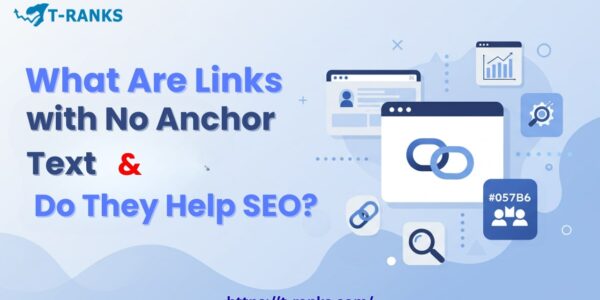In SEO, anchor text is the clickable text you see in a link. It tells Google, and your readers, what the linked page is about.
But here’s the catch: not every link has anchor text.
Sometimes you’ll see:
- A plain raw URL
- A generic “click here”
- Or even an image link without alt text
These still pass authority. But they give Google way less context. Which means the algorithm has to rely on surrounding text and other signals to figure things out.
And with today’s clean, icon-heavy web designs, no-text links are becoming more and more common.
So the question is: do they help, or hurt, your SEO?
That’s exactly what we’re going to cover in this guide.
Understanding Anchor Text in SEO
Anchor text is the clickable text in a link.
It shows Google and your readers what the page on the other side is about.
And not all anchor text looks the same. Here are the main types:
- Exact match: Uses the target keyword word-for-word. Example: “buy running shoes.”
- Partial match: A variation of the keyword. Example: “best shoes for runners.”
- Branded: Uses the brand name. Example: “Nike.”
- Naked URL: Just the raw link. Example: https://example.com
- Image anchor: An image that links somewhere. Google reads the alt text as the anchor.
- No anchor text: A blank link, plain URL, or image with no alt text.
Why does this matter?
Because anchor text gives search engines context. It helps Google connect the source page to the destination page and understand how they relate.
It also makes crawling and indexing easier, since Google can quickly see where each link fits in your site’s overall structure.
What Are Links with No Anchor Text?
A link with no anchor text is a hyperlink without visible, descriptive words between the <a> and </a> tags.
In other words, there’s nothing for users to click on except a bare URL, a blank space, or an image without alt text.
You’ll usually see no-anchor links show up as:
- Empty anchor tags: <a href=”#”> </a>
- Image links with no alt text: <a href=”url”><img src=”image.jpg”></a>
- Raw URLs: pasted directly into content like https://example.com
From a user perspective, these links aren’t very helpful. They don’t give a clue about where the link will lead.
From an SEO perspective, they’re a mixed bag.
Yes, they can still pass link equity. But they strip away valuable context that descriptive anchor text normally provides.
That’s why, during SEO audits, no-anchor links are often flagged. They reduce semantic clarity and make it harder for search engines to connect the dots between your content and the target page.
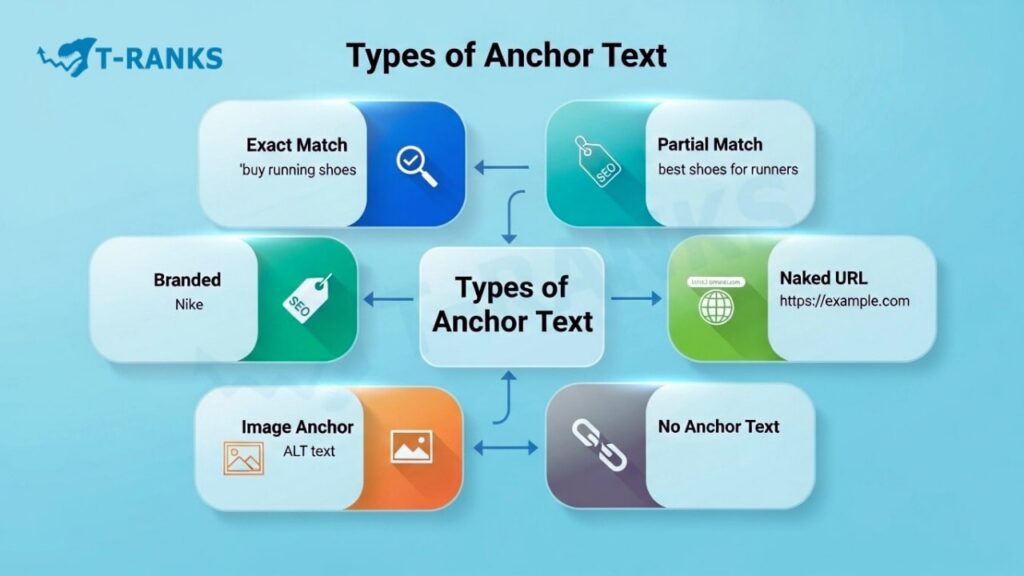
Common Examples of No-Anchor Links
You’ll usually spot no-anchor links in audits or raw HTML. Here are the main types:
1. Empty anchor element
<a href=”https://example.com”> </a>
2. Link with just a symbol or icon
<a href=”https://example.com”>🔗</a>
3. Raw URL dropped in content
In tools like Ahrefs or Screaming Frog, these often show up as “empty anchor” or “no text” warnings.
Image Links Without ALT Text
Google uses the alt attribute of an image as the anchor text.
If there’s no alt, the link has zero descriptive context.
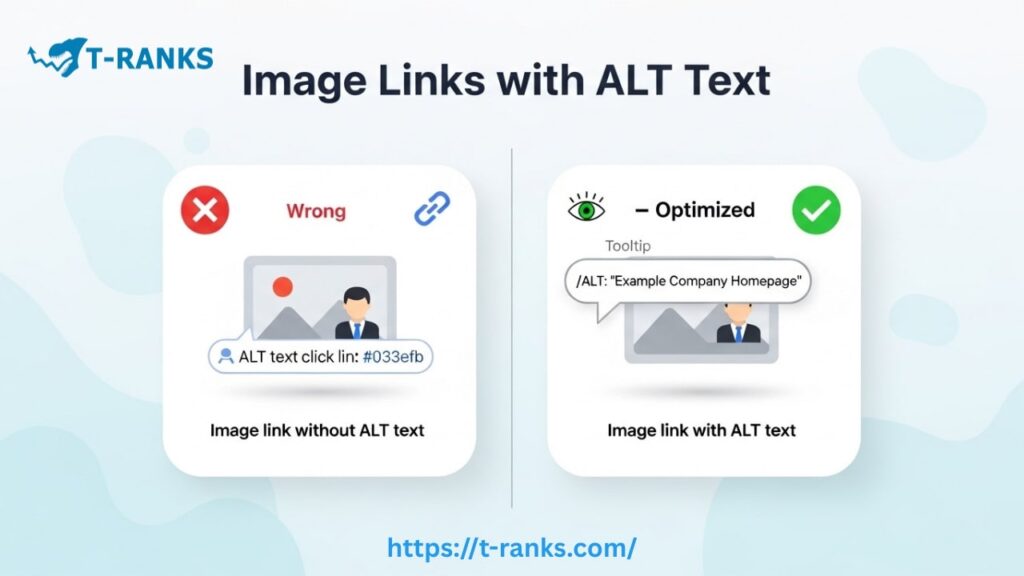
❌ No-anchor image link:
<a href=”https://example.com”><img src=”logo.jpg”></a>
✅ Optimized image link:
<a href=”https://example.com”><img src=”logo.jpg” alt=”Example Company Homepage”></a>
If you’re still not sure how to balance keyword-rich vs branded anchors, check out our full anchor text optimization guide.
How Do These Links Affect SEO?
Anchorless links are a double-edged sword. On the one hand, they can diversify your link profile. On the other hand, they don’t provide Google with strong context about the target page.
Here’s the breakdown:
- Search engines can still follow the link. But without descriptive text, they lose a key signal that explains what the page is about.
- A natural link profile usually has a mix: exact match, branded, naked URLs, and yes, even no-anchor links. If you only have keyword-rich anchors, then it looks manipulative.
- An empty or icon-only link isn’t helpful for visitors. Bad UX can indirectly hurt SEO if users bounce.
Google’s View on Anchorless Links
Google has never flat-out said “anchorless links don’t count.” But we do have clues.
- In Google’s SEO Starter Guide, they emphasize the importance of descriptive anchor text. The implication? Links without anchors are weaker signals.
- John Mueller has also noted in multiple hangouts that Google can still interpret naked URLs or no-anchor links, but they don’t carry the same topical relevance.
Translation: Google doesn’t ignore them, but they’re far from ideal.
When we talk about the importance of anchor text, there’s no better way to dive deeper than through how to build PBN links that work.
Do Anchorless Links Pass Link Juice?
This is a heated debate among SEOs,
On one side:
- Many SEOs believe that anchorless links still pass authority. After all, the link exists in the HTML and can be crawled.
On the other:
- Without anchor context, the link equity is “dumb.” It flows authority, but doesn’t help much with keyword relevance.
As Ahrefs notes in its anchor text guide, anchor text helps Google connect topics. Without it, you’re missing out on that boost.
Bottom line: Yes, they can pass link juice. But compared to keyword-rich anchors, the contextual power is weaker.
Audit: How to Identify Links with No Anchor Text
Anchorless links kill context. The good news? You can spot them fast with crawling and SEO audit tools.
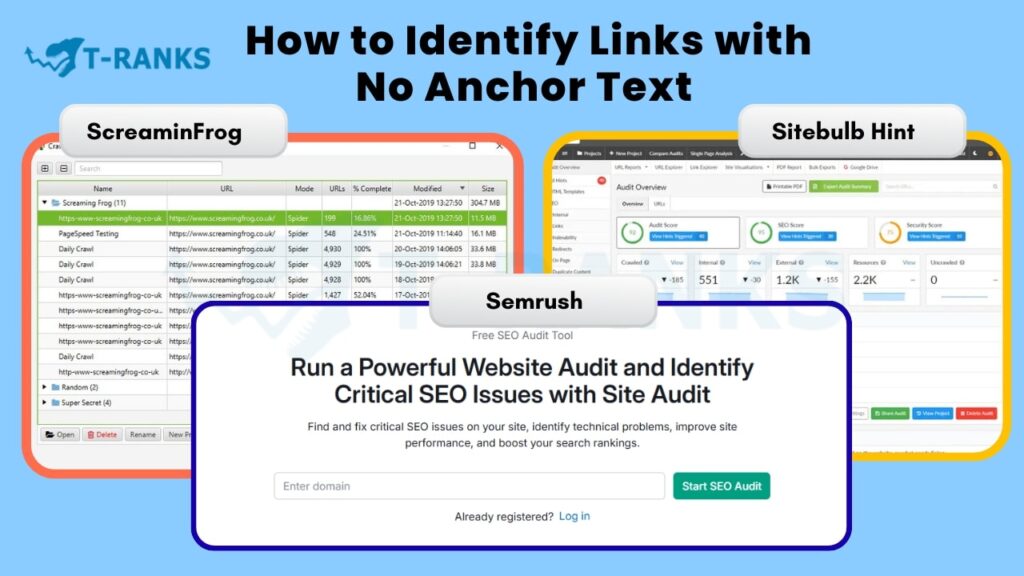
Screaming Frog Audit Example
- Fire up Screaming Frog and run a crawl.
- Head to the Inlinks tab.
- Sort by Anchor Text → look for blanks.
- Export those URLs and fix them.
Most of the time, these are image links without alt text.
Sitebulb Hint and Detection
Sitebulb makes it even easier.
- Run a crawl in Sitebulb.
- Check the Hints under Internal Linking → Anchor Text.
- Anchorless links are flagged automatically with explanations.
You get a ready-made list of anchor text issues without manual digging.
Semrush Backlink Audit
Semrush helps you catch anchorless backlinks.
- Open the Backlink Audit tool.
- Filter by “Anchor” and scan for “N/A” or blank anchors.
- Export the results and prioritize fixes.
👉 This is the fastest way to see which external links give you zero context.
For an in-depth look at how anchor text impacts link-building strategies, check out SEMrush’s Link Building Strategies
How to Fix Links Without Anchor Text
Links with no anchor text are wasted SEO opportunities. They don’t pass context. They don’t boost relevance. And in some cases, they can even confuse Google.
The bright side? Fixing them is simple.
First, you need to find these problematic links. Learn how to use tools to identify anchor text issues by reading our backlink analysis guide. Here’s the 3-step playbook.
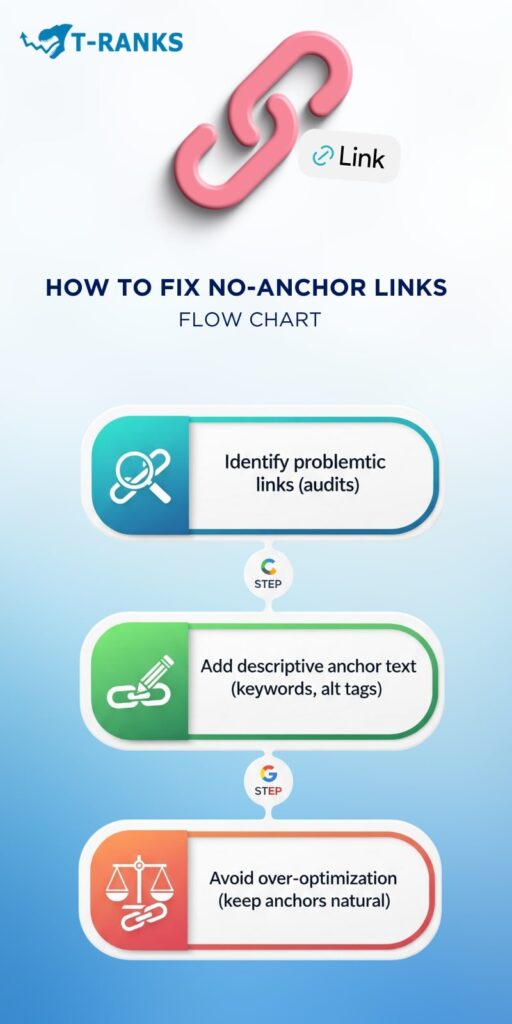
Step 1: Identify Problematic Links
First, you need to know where the issues are hiding.
Fire up Screaming Frog or Ahrefs Site Audit.
Filter for:
- Links with blank anchor fields
- Naked URLs like www.site.com/page
- Generic anchors like “click here” or “learn more”
These are the low-hanging fruit.
Step 2: Add Descriptive Anchor Text
Next, replace those weak anchors with text that actually describes the target page.
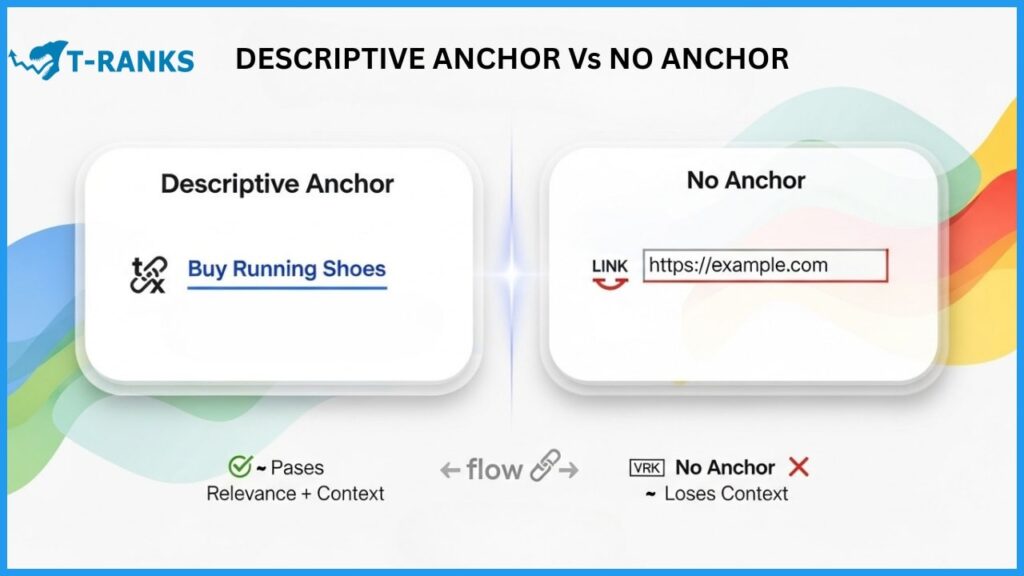
Example:
- Bad: Read more
- Good: On-page SEO techniques
Keep it short, relevant, and contextual.
This makes the link more valuable for both users and search engines.
Pro Tip: If it’s an image link, don’t forget to add an ALT tag. Google reads that like anchor text.
Step 3: Avoid Over-Optimization
It’s tempting to stuff your anchors with keywords. Don’t.
Why? Because a natural anchor profile is key.
Mix it up with:
- Branded anchors, like t-ranks
- Partial match anchors
- Generic anchors (used sparingly)
Think variety. That’s what keeps your link profile looking natural.
When Are Anchorless Links Acceptable for SEO?
Here’s the deal: not every link needs keyword-rich anchor text.
Sometimes, anchorless links (a.k.a. naked URLs or branded links) make perfect sense, both for users and Google.
1. Social Media & Forum Links (Natural Naked URLs)
Most social media shares and community posts use plain URLs.
Google expects this pattern.
These links might not carry huge “anchor text value,” but they still pass authority and validate brand trust.
2. Image Links With ALT Attributes
Got your logo pointing back to your homepage?
That’s an anchorless link.
But here’s the trick: Google often uses ALT text as a proxy for anchor text.
So if your image says <img src=”logo.png” alt=”Company Name”>…
Congrats, you’ve just given Google context.
Brand Mentions Without Keywords
Sometimes a raw URL acts as a brand citation. These anchorless mentions can still build trust and authority, especially when they come from credible sources in your niche.
Case Study: Anchor Text Impact on Rankings
We wanted to see how much anchor text really matters for SEO. To find out, we ran a controlled internal linking test on two sets of nearly identical product category pages.
Test Design
We split the pages into two groups. Both had the same crawl depth, on-page setup, and backlink profiles before the test. The only variable was the anchor text strategy.
- Group A: Got 15 internal links from related articles. Each link used descriptive, keyword-rich anchors like handmade leather backpacks.
- Group B: Got 15 internal links from the same articles. But these links used raw URLs or icons with no alt text.
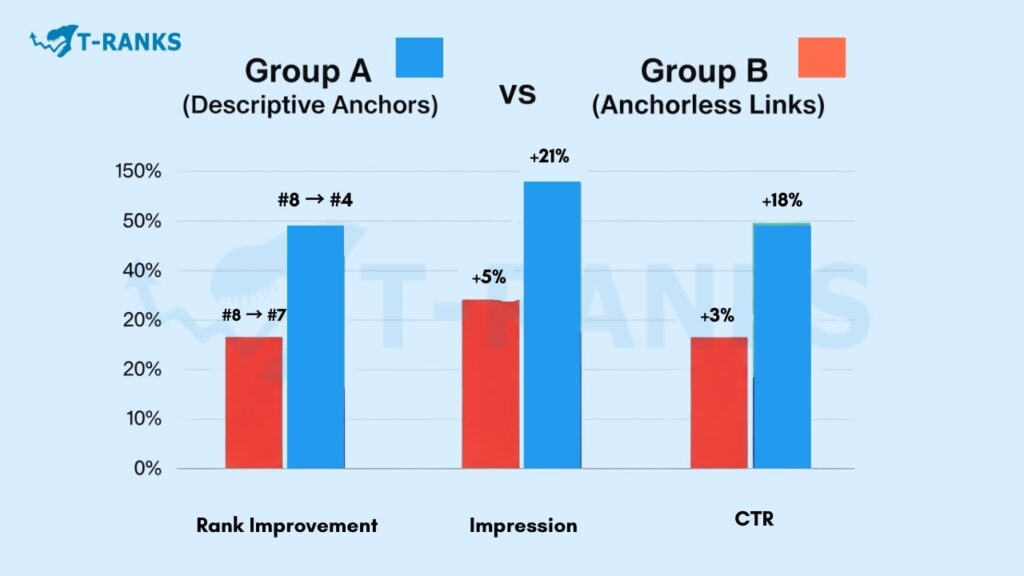
Why This Test Matters
Anchor text is one of the strongest signals Google uses to understand what a page is about. By keeping every other factor equal, we could isolate the role of anchor text in driving rankings. For more detailed information, check out our FAQ page to find answers to common questions.
Results after 6 weeks
| Metric | Group A (Descriptive Anchors) | Group B (Anchorless Links) |
| Avg. ranking position (target term) | #8 → #4 | #8 → #7 |
| Click-through rate (CTR) | +18% | +3% |
| Organic impressions | +21% | +5% |
Want to see real-world results? Our 2500-monthly case study shows how anchor text optimization helped increase traffic significantly
Analysis
Pages with descriptive anchor text shot up the rankings. They also pulled a higher CTR. Clear anchors give Google and users instant context.
Anchorless links passed PageRank. They also helped with crawlability. But they added almost no topical relevance. That’s why rankings barely moved for competitive keywords.
Anchor text is still a strong ranking factor. Anchorless links add diversity, but they won’t move the needle for tough keywords.
Want more tests like this? Check out the T-Ranks SEO Testing Hub.
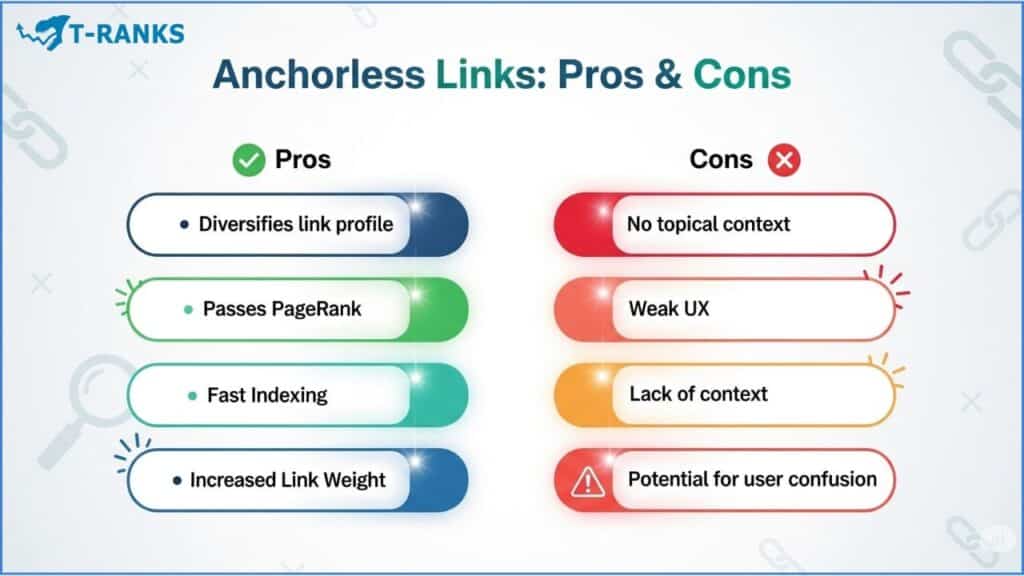
Final Thoughts
Here’s the deal: Anchorless links aren’t “bad.” But they’re not doing you any SEO favors either.
Yes, they still pass PageRank. Yes, Google can crawl them.
But without anchor text, you lose the topical signals that actually move rankings.
So what should you do?
- Audit your site with Screaming Frog, Sitebulb, or SEMrush.
- Fix raw URLs by swapping them for keyword-rich anchors.
- Add descriptive alt text to image links.
- Keep anchorless links only where they make sense (logos, social icons, utility nav).
Bottom line? Don’t wipe out every anchorless link. Just make sure the links that matter carry strong, contextual anchors.
That’s how you get higher rankings, better UX, and a site Google actually understands.
What does it mean when a link has no anchor text?
It means the hyperlink lacks descriptive text or an image alt tag, making it unclear what the linked page is about.
Are links with no anchor text bad for SEO?
They can harm crawlability and dilute anchor profile quality, though some are acceptable depending on context.
Do naked URLs count as links with no anchor text?
Yes, if they are not wrapped with meaningful text or markup, they often register as lacking anchor context.
Can image links without ALT text cause issues?
Absolutely. Without ALT text, they offer no anchor signal to search engines, reducing their SEO value
How do I find internal links with no anchor text?
Use audit tools like Screaming Frog, Sitebulb, or Sitechecker to flag and filter such links from your website structure.
How should I fix links that don’t have anchor text?
Add relevant anchor text, update image alt tags, or restructure your internal linking to ensure semantic flow.
Can links with no anchor text still pass SEO value?
Some link juice may still be passed, but contextual SEO impact is usually much lower than properly anchored links.
Does Google penalize anchorless links?
No direct penalty, but lack of clarity and spam signals can harm page quality scores and ranking potential.
